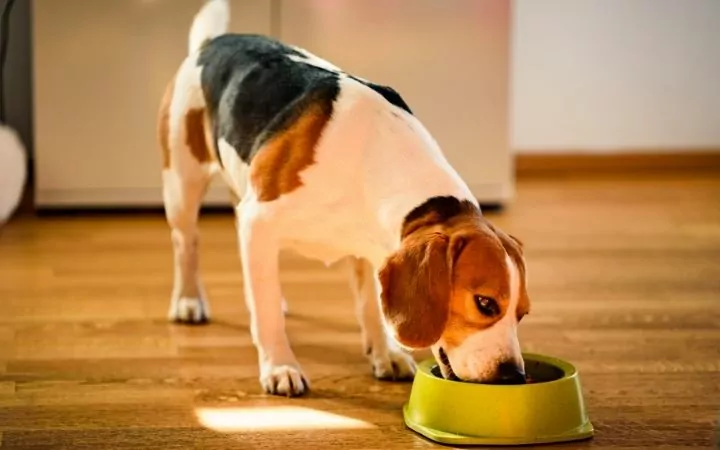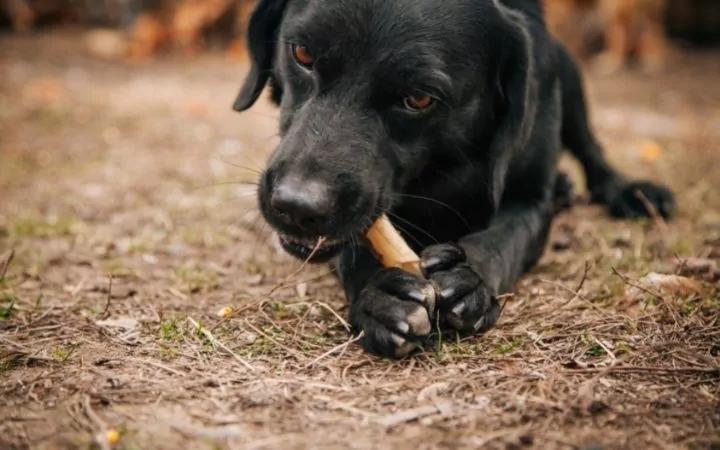The Dog Digestive System
Today we are going to discuss dog diarrhea, what causes it, and what can be done to stop it.
Dogs have very different digestive systems than our own. When we eat food, our teeth, and saliva help to begin the digestive process. Dog’s teeth are designed to tear and crush tissue enough for it to be swallowed quickly.
When the food arrives in the stomach of our pooches, no digestion has occurred. The stomach produces very powerful acid (three times stronger than our own) to allow the food to be broken down.
Once the food is digested, it continues its passage through the small and large intestine where water and nutrients are extracted; anything that can’t be digested exits the body as fecates.
When something goes wrong in this process, we may see vomiting, diarrhea, and flatulence, depending on the problem.
What Classifies as Diarrhea?

Diarrhea is defined as soft or liquid feces that is produced regularly from the bowels. We would usually say your dog has diarrhea if the feces can’t be picked up and doesn’t hold its shape, but this can vary from dog to dog.
The intestines are responsible for extracting nutrients and water from the food resulting in feces. Problems in the body that affect digestion will cause either small- or large intestinal dysfunction, leading to diarrhea.
Other signs you may see associated with diarrhea include vomiting, flatulence, increased drinking, dehydration, weight loss, inappetence, and fever. Other specific signs you may see with diarrhea include the feces’ color, the frequency of toileting, and any straining.
Feces can be classified in many different ways, from color to texture and also the volume of feces. Your veterinarian can use these classifications to help determine the cause of diarrhea and track any response to treatment. Below is a table (Table 1) showing some of the ways feces can be classified.
| Fecal Scoring Chart | ||||
| Shape | Moisture | Can it be picked up? | Does it leave a residue? | |
| Grade 1 | Hard pellets | Dry | Yes | No |
| Grade 2 | Firm but pliable | Some moisture | Yes | No |
| Grade 3 | No segments, logs | Moist | Yes | Yes |
| Grade 4 | No segments, logs | Very moist and soggy | Yes, but it loses its shape | Yes |
| Grade 5 | No shape, piles | Very moist | Yes, but it loses its shape | Yes |
| Grade 6 | No shape, textured | Wet | No | Yes |
| Grade 7 | Puddles | Watery | No | Yes |
You can have a look at the Purina Table as well as a reference point.
The Primary Causes of Dog Diarrhea
Anything that affects digestion can cause diarrhea. The list of possible causes of diarrhea is very long, and today we will cover some possible examples.
Infectious:
- Bacteria: Salmonella, Leptospirosis.
- Parasites: worms (Hookworms, Roundworms, Tapeworms), protozoa (Giardia, Coccidia).
- Viruses, e.g., Parvovirus, Distemper, Coronavirus (NOT COVID-19).
Traumatic:
- Being hit by a car, other physical trauma.
- Swallowing something indigestible causing a foreign body.
- Twisting of the intestines.
- Penetrating wound.
Autoimmune:
- Inflammatory bowel disease (IBD).
- Problems with the lymph nodes in the digestive system (Lymphangiectasia).
Metabolic:
- Organs that control the metabolism can lead to diarrhea.
- Kidney, thyroid, liver, pancreatic disease.
Dietary:
- Sudden changes in diet, especially in puppies.
- Overfeeding or feeding human food, especially fatty foods.
- Feeding something your dog has an allergy to.
- Eating spoiled or rotten food.

Inflammatory:
- Pancreatitis
- Inflammation of the stomach and intestines (Gastroenteritis).
Neoplasia:
- Primary of the liver, pancreas, stomach, and intestines.
- Cancer in other organs in the body can spread (metastasize).
Poisons:
- Chocolate
- Grapes/raisins
- Human medicine
- Toxic plants
- Pesticides
Medications:
- Antibiotics
- Anti-inflammatory medicines (NSAIDs).
- Wormers
Vascular:
- A blood clot can cut off circulation to the intestines, which can be caused by heatstroke or anaphylaxis.
In the table below (Table 2), you can see a list of some diseases that cause abnormal colors of feces.
| Abnormal Colour | Possible Cause |
| Bright red | Fresh blood, bleeding from large intestine or rectum. |
| Green | Eating too much grass, gallbladder problem. |
| Orange/yellow | Liver or gallbladder problem. |
| Dark and sticky | Bleeding from the stomach or small intestine. Could be an emergency; get your pet seen by a veterinarian ASAP. |
| Grey and greasy | Problem with pancreas leading to fat not being digested. |
| Little white flecks or worms | Parasites, tapeworms. |
Is Canine Diarrhea Serious?
As you will have seen in the possible causes of diarrhea explained above, some causes of diarrhea are mild, such as eating grass, while some reasons can be severe and even life-threatening. If you are ever concerned about your dog, it’s best to call your veterinarian for advice.
In general, if you notice your dog has diarrhea, but it resolves quickly and your dog is behaving normally, it is unlikely to be a problem.

Signs that diarrhea is serious include:
- Black tarry feces (melaena).
- Vomiting, especially if water can’t be kept down or if you see blood in the vomit.
- Your dog being listless and not interested in going for a walk.
- Inappetence.
- Diarrhea that lasts for more than a few days.
- Severe diarrhea that isn’t responding to treatment.
- Fever.
- Dehydration or your dog not wanting to drink water.
- Possible toxin ingestion.
- If you suspect your dog has eaten something, it shouldn’t.
- Young puppies and very small dogs have less reserve, so they can get sick much faster than larger adult dogs.
If you are concerned whether or not your dog’s diarrhea is severe, it is essential to arrange to be seen by your veterinarian as soon as possible.
Another important note that if your dog has developed diarrhea from an infectious agent, it is possible for you or someone in your family to get sick also. Always practice good hygiene when handling dog feces but especially if they have diarrhea.
If you develop symptoms of a tummy bug after your pet has been sick, make sure to tell your doctor so that they can pay special attention to infectious diseases.
Which Human Foods can Cause Diarrhea?
Dogs have different digestive systems than ours, something that we digest fine may not sit well in your pooch. It is important to check with your veterinarian before feeding any human food, and if you aren’t sure, it is better not to do it than to risk it.
Rich fatty foods such as ham and bacon can lead to diarrhea. Dog’s cannot digest fat as well as people, and fatty foods can lead to a severe condition called pancreatitis. Even a small piece can cause problems, so it’s best to avoid it entirely.
Grapes and chocolate are toxic to dogs. One sign of toxicity is diarrhea. Never feed grapes or chocolate to your dog (this includes raisins). If you are concerned your pet has eaten it, bring them to the vet straight away so that vomiting can be induced.
Bones that are swallowed can be challenging to digest and get stuck in the intestines leading to a foreign body. This can manifest as diarrhea. Foreign bodies are very serious and may require surgery. When in doubt, it is best not to feed bones. Cartilage is much safer as it can be digested. If you want some suggestions of safe chewy treats for your dog, ask your veterinarian.

Rotten food out of the fridge is not safe for your dog, just like it isn’t safe for us. A common misconception is that since dogs eat carcasses in the wild, they are immune to disease, but that is not always true.
Some bacteria are very tough, and even the powerful stomach acids don’t destroy them, which can lead to infection. Also, rotten meat will likely have a significant bacterial load already present; as bacteria multiply, they release toxins.
Feeding rotten meat can be very toxic. Although a dog might have been fine eating rotten meat previously, this doesn’t mean it will be ok next time. To be safe, it’s better to throw it out.
Scavenging can also lead to diarrhea. If your dog is prone to this, it is best to keep them on a leash while walking and ensure they are well contained in your yard so that they can’t break out. If your dog likes eating feces, make sure to clean up your yard regularly.
Some foods are safe for dogs. Some fruit and vegetables ok, but make sure to do your research before giving anything. Cooked rice, pumpkin and white meat, and white boneless fish such as cod are safe for dogs and can help settle the digestive system after diarrhea. This will be covered further below.
Types of Diarrhea in Dogs
Diarrhea can be classed by the location where the diarrhea is coming from, how long it has lasted, and if it is combined with any other signs (comorbidities).
Small intestinal vs. Large intestinal vs. Mixed Bowel Diarrhea
Ultimately it is the dysfunction of the intestines that leads to diarrhea, and whether the small or large intestine is affected will depend on what signs we see. Differentiating what part of the intestines are involved can help diagnose the issue, as some diseases will affect one or the other or both.
In the table below (Table 3), you can see what signs are linked to what part of the intestines.
| Diarrhea | |||
| Small intestine | Large intestinal | Mixed bowel | |
| Volume of feces | Increased | Decreased | Increased |
| Straining | No | Yes, it can be painful | Yes |
| Projectile | Yes | No | No |
| Blood | Dark and sticky | Bright red | Bright red |
| Urgency | Not urgent | Urgent | Not urgent |
Diarrhea can also be classed by how long it has lasted (acute vs. chronic).
Acute diarrhea is usually something that has occurred within the last 48 hours. It can generally be resolved with little intervention and doesn’t require a visit to the veterinarian.
Chronic diarrhea is anything that lasts more than 48 hours. It doesn’t respond to at-home treatment and may recur. If the diarrhea doesn’t get treated, then it can lead to weight loss, dry coat, and nutritional deficiencies.
Comorbidities such as inappetence or vomiting can help classify diarrhea further. Vomiting with diarrhea shows that the entire gastrointestinal system is upset.
Home Remedies for Canine Diarrhea
As you’ve likely discovered through reading this article, diarrhea can be caused by many different things. Some diarrhea will self-resolve, some will resolve from home remedies, and some will require veterinary attention.
It is not always clear which is which, so if you’re ever concerned, make sure to check with your veterinarian. In general, an adult dog that is well in itself (i.e., still eating, playful, not vomiting) and has had diarrhea for a short period of time will be ok to be treated at home.

Typical advice that veterinarians give their patients are:
- Make sure your dog is up to date with parasite control. This includes flea treatment. If they aren’t, you can treat them to see if that helps.
- Generally, they would not recommend fasting your dog without a veterinarian. Recommending fasting can make things worse, especially in young or small dogs or dogs who are dehydrated.
- Feeding a bland diet little and often can help. Usually, they would recommend either providing a commercial branded food designed for upset stomachs. This is preferred as it is fully balanced. If that’s not an option cooking some food at home can work temporarily. Usually, a 50:50 mixture of boiled chicken (no skin, no salt, no oil) and boiled white rice can be fed little and often throughout the day. Other options include cooked pumpkin, cooked white fish, and egg whites. Dairy is not recommended as dogs usually can’t digest it.
- Over-the-counter products such as probiotics and clay (Montmorillonite or Kaolin) can help settle a stomach and bind the feces.
If your at-home treatment isn’t helping in 48-72 hours, contact your veterinarian or sooner if your dog becomes unwell.
Treating Diarrhea From the Vet’s Perspective
Depending on the cause of diarrhea in your dog will have different treatments prescribed by your veterinarian.
Anti-parasitic medications, food changes, and digestive aids are most commonly used.
Specific treatments may involve medicines such as antibiotics for infections, surgery for trauma and foreign bodies, chemotherapy for cancer, hospitalization for toxicities, and diet changes for IBD.
The cause will determine the prognosis. In mild cases, full recovery is expected, but in more severe cases, the prognosis can vary markedly.
